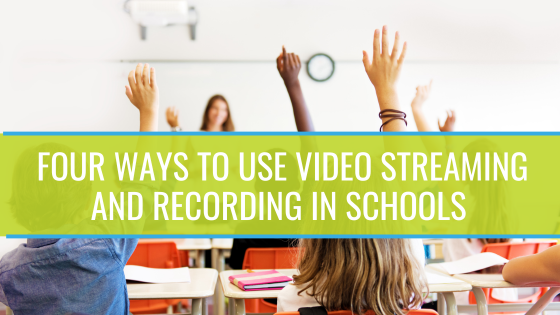As a tool for education, video has a powerful one-two advantage - it's both engaging and versatile. Students respond well to video and video can be used in an amazing variety of applications. That means schools can adapt the technology for nearly any purpose.
Here are four popular video streaming and recording applications, and how they can improve the learning experience for students.
The Ultimate Study Guide: Recorded Videos are Excellent References for Students
At the college level, distance education has long been driven by video streaming and recording. This approach has matriculated down to K-12, where teachers can use technology to record or stream their lessons. There are a couple of obvious, but extremely effective benefits of capturing video in this way:- To support remote students - Video streaming allows remote students to watch along during a live class. With additional collaboration technologies in the classroom (like an interactive flat panel), they can even contribute to the discussion. If your district is still operating on a hybrid model, video streaming makes those hybrid classes possible.
In the past, if a student was out sick, they had no way of participating in class. With video streaming, they can learn from their home.
- To support studying outside of live classes - For any number of reasons, some students just learn better outside of the classroom. In-school stressors can be intense for many, making it difficult for those students to focus on their lessons.
Some of those students just need a different environment to learn in. By recording video content and making it available through an online (secure) platform, students can access class content when they're ready to learn. By giving students agency over their own learning, it's easier for educators to engage their classes.
With video streaming and recording, schools empower their students to learn whenever and wherever they can. Young people have gotten used to absorbing information in this way, so it's an approach that students generally embrace.A How-To Helper: Use Video to Guide Students Through Labs and Other Hands-On Lessons
Video goes well beyond a traditional classroom setting, too. For example, for lessons that include hands-on activities, video can be used as an in-class instructional tool. Labs can be tricky, and it's common for students to disengage if instructions aren't clear. Video can make those instructions clear, using a how-to format that combines visual and aural information. Even better, by deploying video in this way, instructors can roam around the room and provide additional assistance where needed. It's also an opportunity to introduce additional concepts that would otherwise be impossible to, for time reasons. Some schools scale this idea up. In a STEM lab, for instance, schools may install multiple displays around the room - one for each student group. Video instructions can be relayed to all displays at once, providing each group with a close-up look as the teacher walks through the process. Teachers can also use a document camera to provide these instructions live, as anything that's placed in front of the camera can be output to the room's displays.A Safety Assistant: Video Can Demonstrate Proper Safety Procedures in Shop and Lab Classes
While video is typically used in an active role in schools, it's also effective as a passive teaching and messaging tool. For instance, in labs or in shop class where safety procedures are paramount, video can provide safety reminders and demonstrate equipment handling processes. In a woodshop class, small displays can be installed close to each machine. Here, they can output short video loops of people using the equipment properly and pointing out important safety features, like an emergency cutoff or guard. When shop or lab instructors start talking about safety, they typically lose at least some of their audience. Video can reinforce those potentially life-saving concepts by keeping students engaged.Creative Collaboration: Video Can Support an Array of Creative Learning Experiences
Video's versatility lends itself to an array of creative applications. Most schools already let their students handle the morning announcements through video streaming, but this only scratches the surface. The AV clubs of old are no longer around, as they've been replaced by something better - modern AV setups that allow all kinds of students to unleash their creativity. With video streaming and recording, K-12 students can do the following:- Practice a range of occupational skills, including AV installation and production, journalism, and law. Have students give a mock weather forecast, pretend they're in a job interview or deliver a professional presentation - the kind of skills they will need to excel in the workforce.
- Expand their creative aptitude. Tons of creative skills are required for high quality video production. Hardware and tech skills, cinematography, set creation, wardrobe/costume design, video editing, graphic design, writing, elocution, production management - all skills that can enrich a student's creative toolbox.
- Work as a team toward something great. Video production requires a diverse set of skills, so students will need to collaborate to bring their AV ideas to life. And because there are so many roles to fill for video production, there's room for every type of thinker on the team.
- Break free from traditional classroom experiences. Many students thrive when they are allowed to learn outside of a typical classroom setting. They don't want to sit at a desk, they don't learn well through lectures, they're just flat bored – and experimenting with AV gives those students an alternative to traditional classroom learning.



